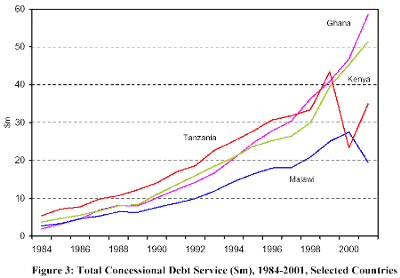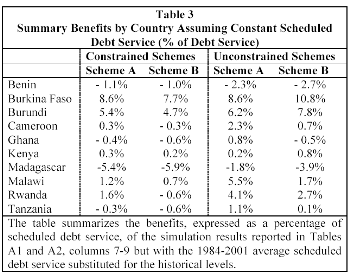Overall, the simulation results reported in sections 4.4 and 4.5 may be seen as positive, in the sense that feasible adjustments of concessional debt service in relation to commodity export and import prices can improve the situation of highly indebted commodity-exporting countries, but negative, in that the estimated size of this benefit is relatively small. They suggest that the extent of Paretian benefits is severely limited – i.e. there is relatively little scope for further improving the position of HIPC debtors without imposing costs on creditors. We have investigated three possible reasons for the mixed results. These are
· variability in concessional debt service over time;
· movements in the price basis (the difference between local and world prices); and
· quantity variation.
Variability of Concessional Debt Service
Concessional debt service has tended to increase over time for the countries in our sample, in some cases relatively fast. This is particularly true of Ghana, Kenya, Malawi and Tanzania – see Figure 3 – and to a lesser extent of Madagascar. At the same time, debt relief under the HIPC programs has resulted in declines in debt service in participating countries.
In Figure 3, this effect is most apparent for Malawi and Tanzania. The result is to introduce sharp variability into otherwise smooth debt service paths. This prompts the question of whether the schemes we are investigating might generate larger benefits if these sources of variability were removed.
Our judgment is that it is the second and third of these factors, and in particular the third, which are largely responsible for the relatively low value that we estimate indebted countries would put on the proposed scheme.

We examined this question by setting concessional debt service to its average value over the period 1984-2001 throughout the entire period. We looked in particular at the results reported in Table 2. The results of this exercise were mixed.
For the constrained swap schemes (column 1 of Tables 2 and 3) four of the ten countries show an improvement, but for the other six this substitution led to deterioration in performance. For the constrained scheme (column 3 of Tables 2 and 3) the results are similar with four improvements and five deteriorations (Ghana shows no change). The conclusions we reached in section 4.4 are unaltered by this experiment.

By Prof. Christopher L. Gilbert, Prof. Alexandra Tabova
Next: Basis Risk
Summary: Index